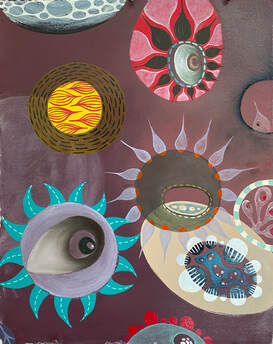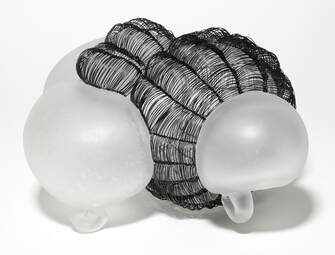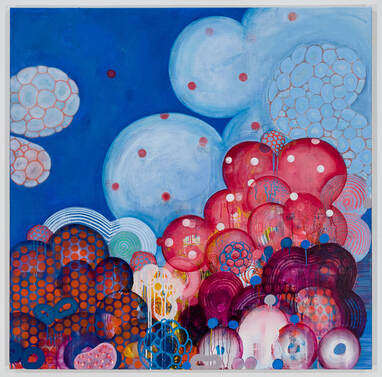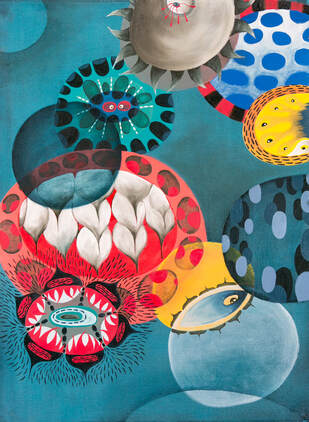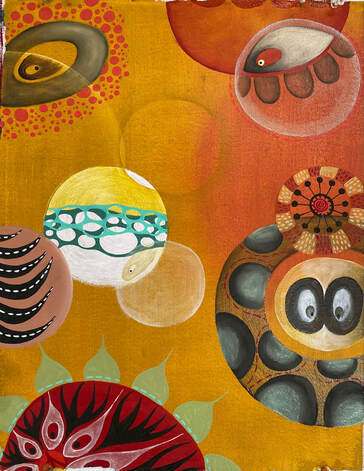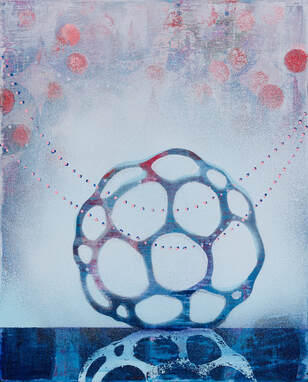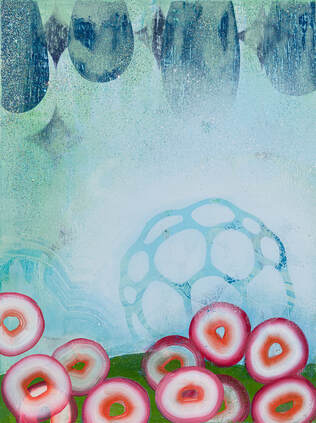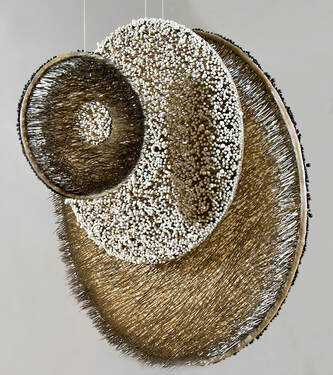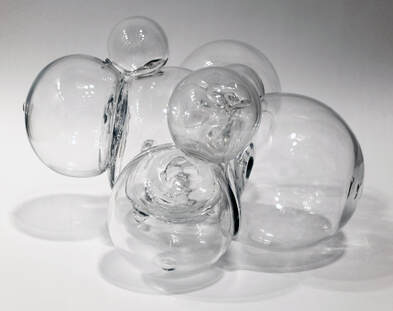BUBBLE THEORY
Melinda Hackett
Sarah Lutz
Beth Dary
April 9 - May 14
Gallery hours:
Wednesday - Saturday, noon - 5pm
|
“Before life on Earth emerged, by about 3.5 billion years ago, the oceans were a soup of randomly jumbled molecules. Then, somehow, some of those molecules arranged themselves into well-organized strings of DNA, protective cell walls, and tiny organ-like structures capable of keeping cells alive and functioning. But just how they accomplished this organization has long baffled scientists. Now, biophysicists at Ludwig–Maximilians University in Munich think they have an answer: bubbles.”
Isobel Whitcomb Live Science August 06, 2019 These three artists, all working separately, have each developed an organic form in their art that references the organic forms best known as bubbles. Beth Dary’s glass and metal sculptures suggest the form bursting from the confines of its cage. The paintings by Melinda Hackett and Sarah Lutz independently celebrate this form, somewhat abstracted, floating in a sea of color. |
|
As Walter Randel has pointed out, there is a long history of bubbles depicted in art; first, if not foremost, by Hieronymus Bosch ( (1450-1516) in THE GARDEN OF EARTHLY DELIGHTS (circa 1490) where in the central panel, we see lovers and other naked forms encase in bubbles suggesting the ephemeral delight in sin before one enters the hell of the painting’s third panel.
More innocently, Jean Simeon Chardin (French 1669-1779) in SOAP BUBBLES and Andriaen Hanneman (Dutch 1603-1671) TWO BOYS BLOWING BUBBLES (1630) showed the playfulness and joy attached to this form. Likewise, Edouard Manet (French 1832-1883) in his painting BOY BLOWING BUBBLES (1867) brought this form to the modern era in painting. In this tradition, the bubble is a symbol of the brevity of life These three artists deal with the form from a 21st century perspective, abstracted from its previous associations. Like the scientists, they treat it as a celebratory ingredient of life |
Melinda Hackett is a New York and Southampton based painter and printmaker. Her work references the natural world as seen through her mind’s eye and is meant to be experienced as a visual playground rather than taken literally. Her forms float in, out and around the surface, occasionally diving in and out of the picture plane. They can be seen as intimate views through a microscope or cosmic views through a telescope. In addition to oil, she works in watercolor, pencil, ink and recently, egg tempera. She collaborates with the sculptor, Michael Drury, to render her forms in bronze, wood and concrete. Her work is in many public and private collections including the Parrish Art Museum in Southampton, LI .
|
Although firmly rooted in abstraction, Sarah Lutz’s work makes clear references to the natural world. She spends as much time as possible near the water: listening, observing, and collecting. Her vocabulary of images has evolved over many years and is deeply personal. These forms are the characters in her story, the narrative within each painting, and the evolving arch of her studio practice. Lutz celebrates the pure physicality of her materials while also exploring their alchemistic and illusory potential. Subject matter and process are seamlessly interwoven; the evolution of each painting, both technically and conceptually, is the subject. Lutz wants her work to be beautiful, but at the same time unsettling; serious, but with a comedic aspect. In each painting, she strives to create a world of light and movement, space and joy that feels at once familiar while hinting at something ethereal and unknown. |
|
Beth Dary holds a Bachelor of Fine Arts from Syracuse University and a Master of Fine Arts from Memphis College of Art. Her work has been exhibited in galleries, arts institutions, and museums nationally and internationally. She has received grants from the Rockefeller Brothers Fund, The Manhattan Community Arts Fund, and she has been commissioned by The Battery Park City Authority in Manhattan to create a public art installation for the Rockefeller Park’s Lily Pond. Dary has also received numerous fellowships, residencies and awards including through Yaddo, the Lower Manhattan Cultural Council, and the Two Trees Cultural Space Subsidy Program. Her work is included in private, corporate and museum collections in the USA and Europe. |

